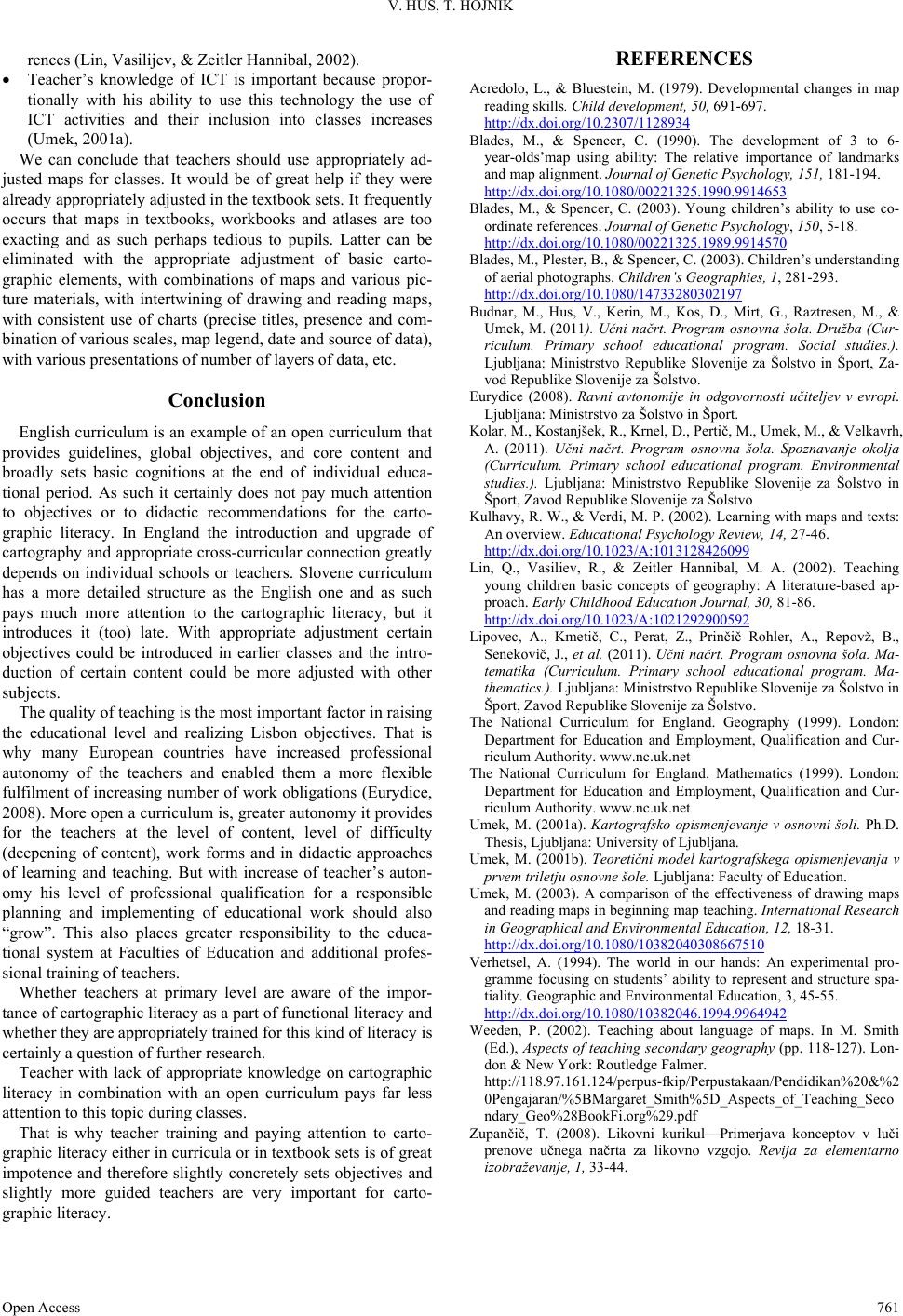
V. HUS, T. HOJNIK
Open Access 761
rences (Lin, Vasilijev, & Zeitler Hannibal, 2002).
Teacher’s knowledge of ICT is important because propor-
tionally with his ability to use this technology the use of
ICT activities and their inclusion into classes increases
(Umek, 2001a).
We can conclude that teachers should use appropriately ad-
justed maps for classes. It would be of great help if they were
already appropriately adjusted in the textbook sets. It frequently
occurs that maps in textbooks, workbooks and atlases are too
exacting and as such perhaps tedious to pupils. Latter can be
eliminated with the appropriate adjustment of basic carto-
graphic elements, with combinations of maps and various pic-
ture materials, with intertwining of drawing and reading maps,
with consistent use of charts (precise titles, presence and com-
bination of various scales, map legend, date and source of data),
with various presentations of number of layers of data, etc.
Conclusion
English curriculum is an example of an open curriculum that
provides guidelines, global objectives, and core content and
broadly sets basic cognitions at the end of individual educa-
tional period. As such it certainly does not pay much attention
to objectives or to didactic recommendations for the carto-
graphic literacy. In England the introduction and upgrade of
cartography and appropriate cross-curricular connection greatly
depends on individual schools or teachers. Slovene curriculum
has a more detailed structure as the English one and as such
pays much more attention to the cartographic literacy, but it
introduces it (too) late. With appropriate adjustment certain
objectives could be introduced in earlier classes and the intro-
duction of certain content could be more adjusted with other
subjects.
The quality of teaching is the most important factor in raising
the educational level and realizing Lisbon objectives. That is
why many European countries have increased professional
autonomy of the teachers and enabled them a more flexible
fulfilment of increasing number of work obligations (Eurydice,
2008). More open a curriculum is, greater autonomy it provides
for the teachers at the level of content, level of difficulty
(deepening of content), work forms and in didactic approaches
of learning and teaching. But with increase of teacher’s auton-
omy his level of professional qualification for a responsible
planning and implementing of educational work should also
“grow”. This also places greater responsibility to the educa-
tional system at Faculties of Education and additional profes-
sional training of teachers.
Whether teachers at primary level are aware of the impor-
tance of cartographic literacy as a part of functional literacy and
whether they are appropriately trained for this kind of literacy is
certainly a question of further research.
Teacher with lack of appropriate knowledge on cartographic
literacy in combination with an open curriculum pays far less
attention to this topic during classes.
That is why teacher training and paying attention to carto-
graphic literacy either in curricula or in textbook sets is of great
impotence and therefore slightly concretely sets objectives and
slightly more guided teachers are very important for carto-
graphic literacy.
REFERENCES
Acredolo, L., & Bluestein, M. (1979). Developmental changes in map
reading skills. Child development, 50, 691-697.
http://dx.doi.org/10.2307/1128934
Blades, M., & Spencer, C. (1990). The development of 3 to 6-
year-olds’map using ability: The relative importance of landmarks
and map alignment. Journal of Genetic Psychology, 151, 181-194.
http://dx.doi.org/10.1080/00221325.1990.9914653
Blades, M., & Spencer, C. (2003). Young children’s ability to use co-
ordinate references. Journal of Genetic Psychology, 150, 5-18.
http://dx.doi.org/10.1080/00221325.1989.9914570
Blades, M., Plester, B., & Spencer, C. (2003). Children’s understanding
of aerial photographs. Children’s Geographies, 1, 281-293.
http://dx.doi.org/10.1080/14733280302197
Budnar, M., Hus, V., Kerin, M., Kos, D., Mirt, G., Raztresen, M., &
Umek, M. (2011). Učni načrt. Program osnovna šola. Družba (Cur-
riculum. Primary school educational program. Social studies.).
Ljubljana: Ministrstvo Republike Slovenije za Šolstvo in Šport, Za-
vod Republike Slovenije za Šolstvo.
Eurydice (2008). Ravni avtonomije in odgovornosti učiteljev v evropi.
Ljubljana: Ministrstvo za Šolstvo in Šport.
Kolar, M., Kostanjšek, R., Krnel, D., Pertič, M., Umek, M., & Velkavrh,
A. (2011). Učni načrt. Program osnovna šola. Spoznavanje okolja
(Curriculum. Primary school educational program. Environmental
studies.). Ljubljana: Ministrstvo Republike Slovenije za Šolstvo in
Šport, Zavod Republike Slovenije za Šolstvo
Kulhavy, R. W., & Verdi, M. P. (2002). Learning with maps and texts:
An overview. Educational Psychology Review, 14, 27-46.
http://dx.doi.org/10.1023/A:1013128426099
Lin, Q., Vasiliev, R., & Zeitler Hannibal, M. A. (2002). Teaching
young children basic concepts of geography: A literature-based ap-
proach. Early Childhood Education Journal, 30, 81-86.
http://dx.doi.org/10.1023/A:1021292900592
Lipovec, A., Kmetič, C., Perat, Z., Prinčič Rohler, A., Repovž, B.,
Senekovič, J., et al. (2011). Učni načrt. Program osnovna šola. Ma-
tematika (Curriculum. Primary school educational program. Ma-
thematics.). Ljubljana: Ministrstvo Republike Slovenije za Šolstvo in
Šport, Zavod Republike Slovenije za Šolstvo.
The National Curriculum for England. Geography (1999). London:
Department for Education and Employment, Qualification and Cur-
riculum Authority. www.nc.uk.net
The National Curriculum for England. Mathematics (1999). London:
Department for Education and Employment, Qualification and Cur-
riculum Authority. www.nc.uk.net
Umek, M. (2001a). Kartografsko opismenjevanje v osnovni šoli. Ph.D.
Thesis, Ljubljana: University of Ljubljana.
Umek, M. (2001b). Teoretični model kartografskega opismenjevanja v
prvem triletju osnovne šole. Ljubljana: Faculty of Education.
Umek, M. (2003). A comparison of the effectiveness of drawing maps
and reading maps in beginning map teaching. International Research
in Geographical and Environmental Education, 12, 18-31.
http://dx.doi.org/10.1080/10382040308667510
Verhetsel, A. (1994). The world in our hands: An experimental pro-
gramme focusing on students’ ability to represent and structure spa-
tiality. Geographic and Environmental Education, 3, 45-55.
http://dx.doi.org/10.1080/10382046.1994.9964942
Weeden, P. (2002). Teaching about language of maps. In M. Smith
(Ed.), Aspects of teaching secondary geography (pp. 118-127). Lon-
don & New York: Routledge Falmer.
http://118.97.161.124/perpus-fkip/Perpustakaan/Pendidikan%20&%2
0Pengajaran/%5BMargaret_Smith%5D_Aspects_of_Teaching_Seco
ndary_Geo%28BookFi.org%29.pdf
Zupančič, T. (2008). Likovni kurikul—Primerjava konceptov v luči
prenove učnega načrta za likovno vzgojo. Revija za elementarno
izobraževanje, 1, 33-44.